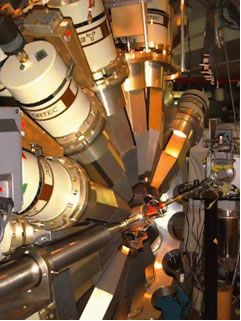GAMMASPHERE AT ANL
The SFU Nuclear Science group is involved in experiments using GAMMASPHERE in conjunction with auxiliary detectors at Argonne National Laboratory close to Chicago, USA.
What is GAMMASPHERE?

Half of GAMMASPHERE
GAMMASPHERE is a spectrometer for gamma-ray detection. It consists of a spherical shell of 110 large volume, high-purity germanium detectors, each enclosed in a bismuth-germanate Compton-suppression shield. It is currently located at Argonne National Laboratory closed to Chicago in USA.
It is used to detect gamma-ray radiation of excited nuclei produced in nuclear reactions, such as fusion evaporation reactions.
For more information, please read the GAMMASPHERE on line booklet at http://nucalf.physics.fsu.edu/~riley/gamma/.
What ancillary detectors can we use with GAMMASPHERE?
Microball
The Microball is a detector for light charged particle. It consists of 95 CsI(Tl) scintillators closely packed to cover the angular range 4.0° - 172°. The detectors are arranged in 9 rings with increasing forward segmentation. The device is optimally designed to be used in conjunction with Gammasphere. The scintillator light is collected by silicon photodiodes that provide high quantum efficiency and minimal mass. The signals are processed through a charge sensitive preamplifier followed by a slow shaper. Particle identification for 1,2,3H, 3,4He, Li, Be and B ions is accomplished by pulse shape discrimination.
http://www.chemistry.wustl.edu/~dgs/mball/index.html
Neutron Shell
The Neutron Shell was designed especially for use in conjunction with the Gammasphere and often with the Microball for the purpose of selecting one and two neutron evaporation channels in very neutron deficient systems for far from stability gamma-ray spectroscopy. The Neutron Shell consists of up to 30 tapered hexagonal detectors that replace the 30 Ge-BGO modules of the 6 most forward rings of Gammasphere.
http://www.chemistry.wustl.edu/~dgs/NeutronShell/NeutronShell.html

The GAMMASPHERE, MICROBALL and Neutron Shell
FMA
The Fragment Mass Analyzer (FMA) is a recoil mass spectrometer located at the ATLAS accelerator at ANL. It is used to separate nuclear reaction products from the primary heavy ion beam and to disperse them by mass/charge (M/q) at the focal plane.
What experiments are we involved in?
Search for excited states in 58Zn
We propose to study the excited states in 58Zn via the 24Mg (36Ar,2n)58Zn reaction with an 36Ar beam energy of 92 MeV using GAMMASPHERE coupled to the Microball and the FMA. The recoiling ions will be detected by microchannel plate detectors and Z identification will be achieved with an ionization chamber. 58Zn (Z=30, N=28) is the mirror partner if 58Ni (Z=28, N=30) and the only missing link in the completion of the A = 58 T =1 Zn-Cu-Ni triplet. The identification of excited states in the proton-rich 58Zn nucleus will allow us to investigate the isospin symmetry of N~Z nuclei heavier than nickel, and the angular momentum dependence of the isovector and isotensor parts of the nuclear interaction. Comparison with shell-model calculations will provide essential information, such as single-particle energies and two-body matrix elements, and will increase our knowledge of the behaviour of the isovector and isotensor energy differences in the upper fp shell. Furthermore, 58Zn plays an important role in the continuation of the rp-process beyond 56Ni, in the formation of heavy elements in X-ray bursts via 57Cu(p,γ) 58Zn. Spectroscopic information on weakly bound proton states is essential in the stellar reaction rate calculations.

Schematic view of the set-up.
Links
GAMMASPHERE at ANL http://www.phy.anl.gov/gammasphere/
GAMMASPHERE at BNB http://www-gam.lbl.gov/
MICROBALL http://www.chemistry.wustl.edu/~dgs/mball/index.html
Neutron Shell http://www.chemistry.wustl.edu/~dgs/NeutronShell/index.html


